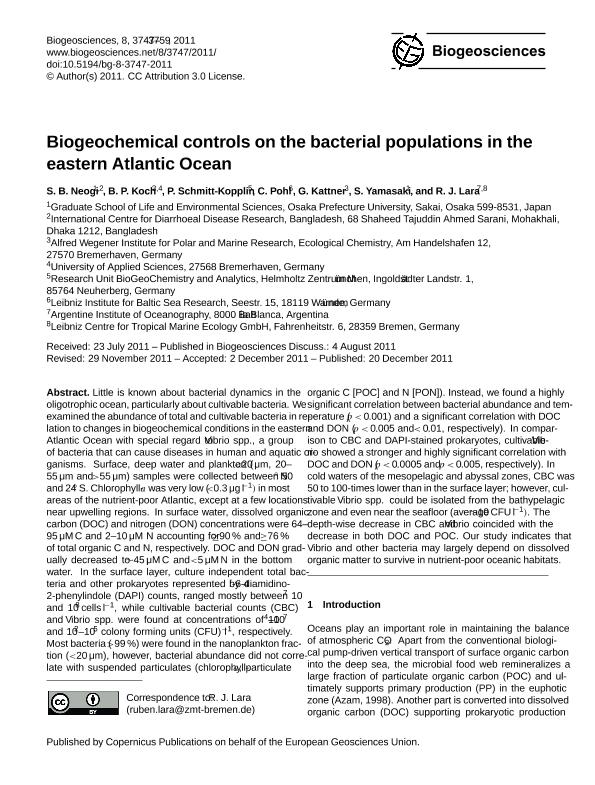Artículo
Biogeochemical controls on the bacterial population in the eastern Atlantic Ocean
Neogi, Sucharit Basu; Koch, Boris Peter; Schmitt Kopplin, Philippe; Pohl, Christine; Kattner, Gerhard; Yamasaki, Shintaro; Lara, Ruben Jose

Fecha de publicación:
07/2011
Editorial:
Copernicus Publications
Revista:
Biogeosciences
ISSN:
1726-4170
e-ISSN:
1726-4189
Idioma:
Inglés
Tipo de recurso:
Artículo publicado
Clasificación temática:
Resumen
Little is known about bacterial dynamics in the oligotrophic ocean, particularly about cultivable bacteria. We examined the abundance of total and cultivable bacteria in relation to changes in biogeochemical conditions in the eastern Atlantic Ocean with special regard to Vibrio spp., a group of bacteria that can cause diseases in human and aquatic organisms. Surface, deep water and plankton (<20 µm, 20– 55 µm and >55 µm) samples were collected between 50◦ N and 24◦ S. Chlorophyll-a was very low (<0.3 µg l−1 ) in most areas of the nutrient-poor Atlantic, except at a few locations near upwelling regions. In surface water, dissolved organic carbon (DOC) and nitrogen (DON) concentrations were 64– 95 µM C and 2–10 µM N accounting for ≥90 % and ≥76 % of total organic C and N, respectively. DOC and DON gradually decreased to ∼45 µM C and <5 µM N in the bottom water. In the surface layer, culture independent total bacteria and other prokaryotes represented by 40 -6-diamidino- 2-phenylindole (DAPI) counts, ranged mostly between 107 and 108 cells l−1 , while cultivable bacterial counts (CBC) and Vibrio spp. were found at concentrations of 104–107 and 102–105 colony forming units (CFU) l−1 , respectively. Most bacteria (>99 %) were found in the nanoplankton fraction (<20 µm), however, bacterial abundance did not correlate with suspended particulates (chlorophyll-a, particulate organic C [POC] and N [PON]). Instead, we found a highly significant correlation between bacterial abundance and temperature (p < 0.001) and a significant correlation with DOC and DON (p < 0.005 and < 0.01, respectively). In comparison to CBC and DAPI-stained prokaryotes, cultivable Vibrio showed a stronger and highly significant correlation with DOC and DON (p < 0.0005 and p < 0.005, respectively). In cold waters of the mesopelagic and abyssal zones, CBC was 50 to 100-times lower than in the surface layer; however, cultivable Vibrio spp. could be isolated from the bathypelagic zone and even near the seafloor (average ∼10 CFU l−1 ). The depth-wise decrease in CBC and Vibrio coincided with the decrease in both DOC and POC. Our study indicates that Vibrio and other bacteria may largely depend on dissolved organic matter to survive in nutrient-poor oceanic habitats.
Palabras clave:
Atlantic
,
Oligotrophic
,
Doc-Iron
,
Bacteria
Archivos asociados
Licencia
Identificadores
Colecciones
Articulos(IADO)
Articulos de INST.ARG.DE OCEANOGRAFIA (I)
Articulos de INST.ARG.DE OCEANOGRAFIA (I)
Citación
Neogi, Sucharit Basu; Koch, Boris Peter; Schmitt Kopplin, Philippe; Pohl, Christine; Kattner, Gerhard; et al.; Biogeochemical controls on the bacterial population in the eastern Atlantic Ocean; Copernicus Publications; Biogeosciences; 8; 7-2011; 3747-3759
Compartir
Altmétricas



